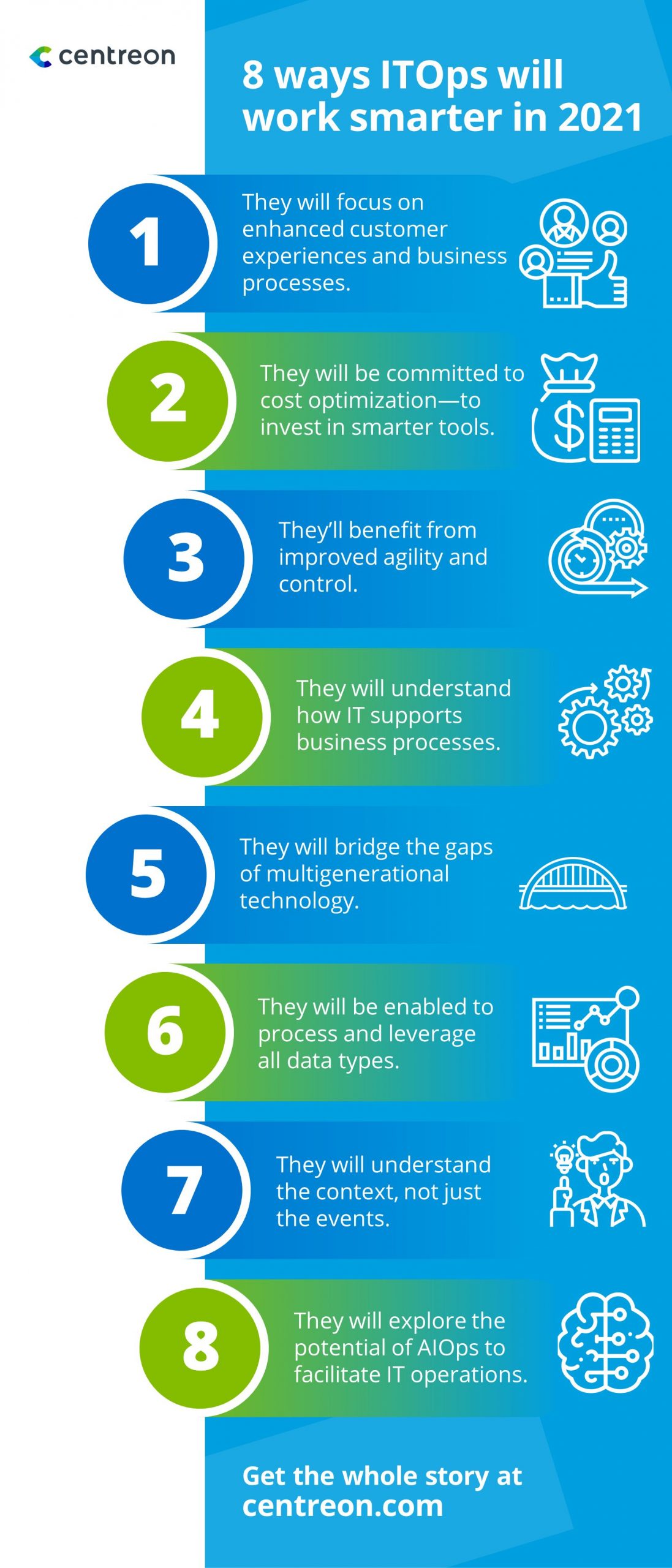We’re (almost) done with 2020. It will be remembered for the pandemic—but also for accelerating the transition from IT systems to smart digital mesh. ITOps will also remember 2020 as the year they needed their own upgrade to a smarter toolbox, matching the digital business technological deployments in response to the post-pandemic reality. From evolved digital workplaces, a new culture is emerging—and in turn, the way ITOps work will change in 2021.

8 Ways ITOps will work smarter in 2021
1. They will focus on enhanced customer experiences and business processes through seamless end-to-end monitoring of the full diversity of applications residing on premises or in the cloud and interacting with users and connected devices at the edge of the network.
2. They’ll be committed to cost optimization—to invest in smarter tools. Typically, up to 14 monitoring tools* are used to monitor middleware and applications that are part of modern IT workflows, from cloud to edge. The more tools there are, the more cumbersome the processes, the higher the costs, not to mention the counterproductive silos. ITOps will now work with tools that are modular, expandable to their needs, and pay only for what they use—budgets will be adequate to real-time needs.
3. They’ll benefit from improved agility and control. Given the digital business highly dynamic environments and ephemeral workflows, there’s a constant ebb and flow of software-defined network (SDN) elements, AWS or Azure cloud assets, Wi-Fi access points or any other such components to keep track of, which require robust automation capabilities. In 2021, with the right tool set ITOps will be able to automate repetitive or resource-intensive tasks.
4. They will understand how IT supports business processes. Managing complex layers of new and legacy infrastructure requires highly visual tools that go well beyond managing alerts in a worksheet-like screen. Through a business and user aware platform, ITOps will be able to understand the contribution of individual IT components to end-to-end service or business workflows, aided by visual service maps that are constantly up to date.
5. They will bridge the gaps of multigenerational technology. IT service is in a continuous state of invention and reinvention as it is always expected to deliver more innovation, more cost effectively, with greater speed and agility. Facing the daunting task of maintaining a patchwork of old and new technologies while preparing for the next stage of digital transformation, ITOps will benefit from flexible, modular and open tools to integrate the full range of their IT estate into one collaborative monitoring platform—from legacy assets to the technology they will be adopting later this year.
6. They will be enabled to process and leverage all data types. The digital business today operates in the cloud, at the edge, and everywhere in between, connecting people, processes and things to optimize customer experience. ITOps will be enabled to measure KPIs and track SLAs through the collection of a rich diversity of data that can be contextualized and turned into insights.
7. They will understand the context, not just the events. In a highly interconnected digital environment, ITOps will no longer just be content with acknowledging events and patching issues. They will seek context across IT layers, effortlessly processing a diversity of data types that can be correlated to main business KPIs. This will enable the business to constantly optimize the network and inform technological decisions.
8. They will explore the potential of AIOps to facilitate IT operations. In the context of digital workplaces, AIOps will become a critical capability to successfully operate an IT infrastructure. ITOps will have a clear roadmap to augment human capacities, making future-ready technological choices from the earliest days of 2021.





